IDW’s first volume of the collected DOCTOR WHO OMNIBUS is a compact but substantial little tome gathering two long story arcs (“Agent Provacateur” and “The Forgotten”) and six one-shots that appeared in single issue form featuring, for the most part, the adventures of the 10th Doctor. The production values on the collection are reasonably high, with a fairly sturdy card cover and no fewer than 416 glossy pages. At the cost of $29.99, it’s the kind of book that would probably give your budget a moment’s pause, weighing the quality versus the dosh. What may seal the deal are those one-shots, which are the particular strength of the work. If purchased as issues, they would nearly add up to the cost of the book, nearly, and there’s plenty in the one shots to inspire a WHO fan to read them, and to want to keep in their collection.
In the end, the major selling point of the Omnibus is that it’s an omnibus: 18 comics in one place, fairly portable and likely to last. Add to that the fact that as Volume 1, we can expect future volumes to stand alongside it. If you ponder buying it as long as it’s taken to read these ruminations, you’ll probably decide that it’s not a bad deal. The evocative cover by comics atmosphere king Ben Templesmith, the retro minimalist faux-weathered bindings, a decent table of contents: all winning features. But let’s talk about those one-shots. Kicking them off is the Templesmith illustrated work that led to the book’s cover, coupled with the fortuitous match of scripting by Leah Moore and John Reppion, “The Whispering Gallery”. It is, quite simply, a tour de force in bravado-free bravura visual narrative, encapsulating many of the things that make Doctor Who stories so appealing in the first place. Templesmith’s combination of muted photographic images and carefully selected inking form an uncanny combination of his signature use of angular lines and the ghostly impression of watching the television series under David Tennant’s incarnation. Appropriate since the storyline revolves around the haunting presence of the regretful dead among the living. If you’re a fan of Templesmith’s trademark distillation of light, often emanating as if from within objects and picking out details that might otherwise be overlooked, he hasn’t reigned it in here for the sake of a licensed property or uniformity with the rest of the comics run. Templesmith manages to use light the way that film noir uses the dark, creating mystery and a sense of the unfamiliar that throws assumptions off guard.
Moore and Reppion reign that mysterious quality in firmly, as the Doctor and Martha squabble over running out of milk for tea, then let it run rampant by introducing an ingenious setting: a gallery of paintings commemorating dead souls laced with the spiritual signatures of their final wishes and thoughts. Add one freaky monster, a planet full of chronically repressed aliens, and some soul searching about how to live without regrets and you get a comic worthy of a particularly high pedestal in WHO cosmology. One uniquely resonant feature of “The Whispering Gallery” is the way in which Templesmith’s art and Moore and Reppion’s script work together to create psychological states for both the Doctor and Martha, a combination that may suggest the strength of the comics medium to outdo even the TV series itself.
“The Time Machination”, written by Tony Lee, with art by Paul Grist and colors by Phil Elliot, is another keeper. The art style immediately pops, bringing something new and interesting to a presentation of the Doctor’s life. Its heavy, neatly picked out lines and blocks of color have more than a little hint of Herge’s TINTIN, which alone is enough to make you reconsider your view of the Doctor. He’s an adventurer, after all, and one given to regeneration and shape-changing, but the art style reminds you that he’s also genre-jumping. The story, set in London in 1899, is a little heavy on the dialogue, but that’s to be expected when the Doctor sports a deer-stalker and is narrated by H.G. Wells. Bravo to Lee for bringing in the Doctor-hunting machinations of the Institute (later known as Torchwood), building on further TV elements and reminding readers that within the Doctor’s life story are many overlapping and intersecting lines of temporal movement, only a very few of which are actually depicted in the TV series.
“Black Death, White Life” could almost be termed a horror comic in style and content, yet another leaf in the pages of possibility for Doctor Who antics. With script and colors by Charlie Kirchoff, and art by Tom Mandrake, it conjures another side of the Doctor and his adventures: those dealing with things lurking in the dark, true threats to human existence in scaly and poisonous form. Set during the Black Death plague, the Doctor and Martha find themselves in the midst of an interstellar conflict on the cellular level, and Mandrake renders his peasants earthy and solid, his plague doctors with beaked masks truly sinister while still displaying the versatility to break into cosmic and alien forms that are on par with the “wonder” element of many a WHO TV episode. The comic is also built on a sound and gradual revelation of plot so characteristic of the show, but in this one-shot format, this team faced the greater challenge of posing, addressing, and resolving a complex concept in rather brief form. “Black Death, White Life” displays the kind of detail in art and plotting that argues for the artistic place of Doctor Who comics alongside the TV series, rather than as a purely secondary format.
416 pages allows for dozens, if not hundreds of Whovian worlds to explore and as many missing “moments” from the life of the Doctor to reconstruct in building his disjointed life-narrative. The comics contained in the Omnibus also make ready use of flashbacks and commentary on other regenerations of the Doctor, while grounding the gist of the narrative sweep in the 10th Doctor’s adventures. They combine the heavy and the light elements of the Doctor’s interactions with other sentient beings, and shed a fair amount of light on his psychology, striking notes both familiar to fans and those suggested but never fully explored before. All of this still may not make you want to shell out $29.99, but that’s not a total deal-breaker since an omnibus is precisely the kind of solidly crafted comics extravaganza that should make its way to a library near you. It’s a collection as varied as the Doctor’s own travels in his unpredictable TARDIS. Like the Doctor, you don’t always know where you’ll end up, but with the DOCTOR WHO OMNIBUS, that’s an appealing feature.
Title: DOCTOR WHO OMNIBUS, 1/ Publisher: IDW/Creative Team: Writers: Gary Russell, Leah Moore, John Reppion, Tony Lee, John Ostrander, Richard Starkings, Rich Johnston, & Charlie Kirchoff/Artists: Nick Roche, Jose Maria Beroy, Stefano Martino, Mirco Pierfederici, Ben Templesmith, Paul Grist, Kelly Yates, Adrian Salmon, Eric J, Tom Mandrake, & Pia Guerra
Hannah Means-Shannon writes and blogs about comics for TRIP CITY and Sequart.org and is currently working on books about Neil Gaiman and Alan Moore for Sequart. She is @hannahmenzies on Twitter and hannahmenziesblog on WordPress.


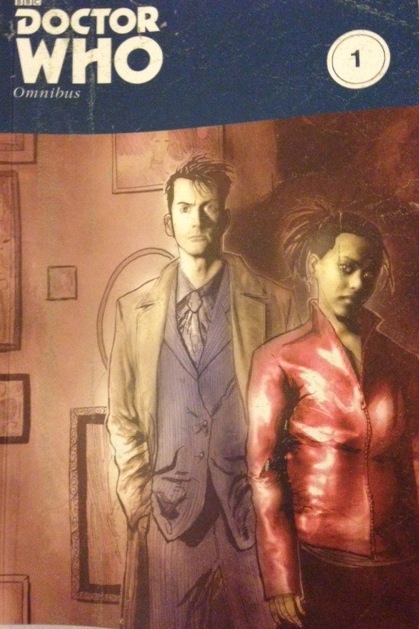
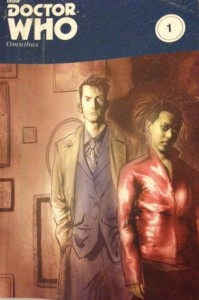
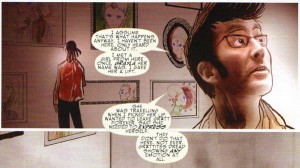
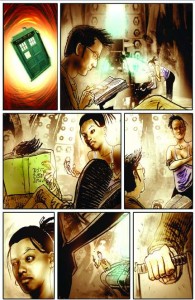
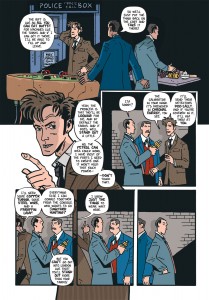
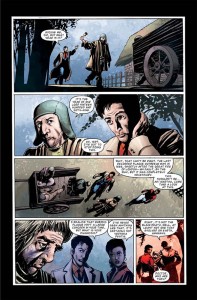


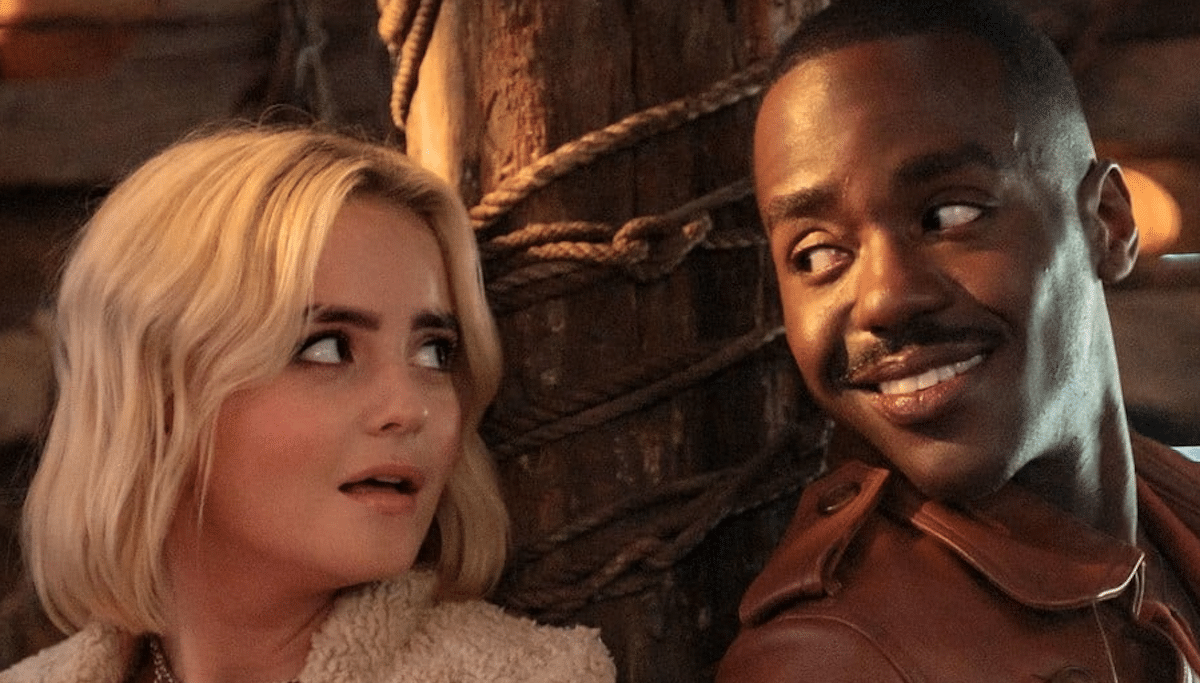



You’re being suspiciously circumspect about the miniseries ‘Agent Provocateur’ and ‘The Forgotten’, which comprise the bulk of this collection. I’m sure the new reader would find gems among the shorter items, but the fact remains that the first thing to confront them will be an incoherent made-up-as-it-goes-along epic by a writer whose only discernible talents seem to be a) getting well-connected enough in Doctor Who fandom that he’s always invited to write these gigs despite his entire fictional output being barely publishable and b) squeezing more expositional text into word balloons than you’d find in entire chapters of most technical manuals. ‘The Forgotten’ is marginally better but does rather resemble an elephant farting pointless Doctor Who references into a wind tunnel for 6 issues.
Though I don’t have quite as negative a view of the longer story arcs, I do find them less exciting.
I particularly like the range of diverse art styles that one shots bring in.
Comments are closed.